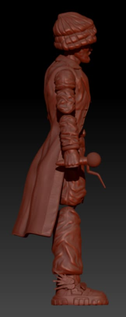THE FIRST STEPS: Breathing Life into AUDACI Through 3D Design
- Shayne Larcher

- Apr 6
- 5 min read
Updated: Jul 5
What began as a search for an artist with both technical prowess and a passion for storytelling led us to a hidden gem in Calgary, Alberta. Amid the flat, open landscapes of the Canadian prairies, we found a digital sculptor by the name of Chi Ho Lo, whose dedication to craft and precision was only matched by his love for imaginative play and character building. This artist, rooted in a region often overlooked in conversations about global design culture, stood out for his deep understanding of form, articulation, and personality in 3D modeling—particularly in the niche of ball-jointed action figures. His portfolio showcased an expert level of attention to anatomical accuracy, engineering functionality, and cultural nuance, offering exactly what we needed to bring our universe to life in physical form. After thorough research of his past work, his expertise to provide the structural complexity necessary for functional articulation became immediately evident. He was not just a modeler—he was a storyteller in digital clay. Every figure he sculpted demonstrated an intentionality that mirrored the kinetic potential of real-world movement. We studied his rigging pipelines, articulation points, and the subtle ways he designed each joint for maximum mobility without compromising form. His approach respected both the physics of toys and the poetics of character design, proving he could offer far more than just a surface-level replica. He brought an understanding of how digital bones and meshes could breathe life into a character, allowing for emotional expression even in stillness.
From the beginning, this was a cross-medium mission. These figures were not only to be static collectibles, but multi-purpose characters that could leap from shelf to screen. By designing with stop-motion in mind, we ensured the models were physically viable—with durable joints, replaceable parts, and natural movement arcs for nuanced animation. Parallel to this, we worked closely to future-proof the geometry so it could be seamlessly retopologized and rigged for real-time use in Unreal Engine 5.5. That meant optimized mesh flows, smart UV unwrapping, and edge loop precision—all while preserving character integrity. We were essentially building transmedia avatars: digital souls ready for tangible life, cinematic animation, or immersive gaming.
We embraced duality in the design philosophy. While articulation was a priority—allowing characters to be posed dynamically for storyboarding, animation, or interactive play—we also envisioned these figures as frozen moments of mythology. Static prints, posed in their archetypal forms, would serve as artistic shrines to each character's essence. These figures could sit proudly on a collector’s shelf as sculptures, evoking the same reverence we hold for ancient figurines or comic statues. The contrast between movement and stillness, between digital files and physical embodiment, mirrored the journey of the Black diaspora—rooted in motion, yet always preserving memory.
Greg Hawkins, a visionary whose original 2D illustrations defined the core aesthetic of our characters, provided the DNA for this project. His designs carried soul—each line sketching not just anatomy but lived experience. In honoring Greg’s visual language, we ensured that every sculpt was a conversation between mediums, with 3D bringing dimensionality to the emotional and cultural depth of his illustrations. The goal wasn’t just visual fidelity—it was spiritual translation. We weren’t merely adapting; we were collaborating across dimensions, fusing analog and digital disciplines to carry a shared vision forward into new realms of possibility.

This loop—from pencil sketch to digital sculpt to physical toy—embodied our core ethos: reimagining what it means to create culture. Our process mirrored ancestral practices, where oral storytelling evolved into written lore and then into visual mythology. Here, analog artistry birthed digital futures, and those futures were reformed into tactile artifacts. These figures weren’t just playthings—they were portals. Each one held the potential for roleplay, therapy, imagination, and ritual. Whether used for display or storytelling, they allowed fans—especially young Black creatives—to touch and hold heroes who reflected their own complexity.
Those of us raised in the 90s were blessed with a golden era of action figures. We watched our imaginations come to life in bedroom battles and backyard adventures. Whether it was G.I. Joe, Transformers, Spider-Man, Spawn, or a beloved Bionicles LEGO set, these toys gave us language, agency, and a safe space to experiment with identity. Films like Toy Story and SMALL SOLDIERS further taught us to animate these figures with meaning—to see them not just as molded plastic but as characters with dreams, memories, and power. For us, building the SLO action figure line wasn’t just a business move. It was childhood closure and creative revolution. It was the reclaiming of a dream that, for many Black kids, never looked like us.
Choosing AUDACI as the starting point was no coincidence—it was prophecy. As the embodiment of futuristic Black expression in it's inception, AUDACI doesn’t just exist in our fictional universe; he speaks to real-world struggles and triumphs. He represents the explosive beauty of survival, self-love, and rebellious joy in a world that often dehumanizes Black creativity. To sculpt AUDACI was to sculpt the first step of the Black Experience through a speculative lens—one that doesn’t shy away from pain, but transforms it into power, rhythm, and shockwaves. Chi Ho Lo, known for his deep respect for cultural storytelling through design, was the perfect artist to breathe life into him.
AUDACI’s essence is liberation through chaos—a refusal to be boxed in, even when the world tries to cage his spirit. He moves like electricity, unpredictable yet necessary. For so many Black individuals navigating predominantly white or hostile spaces, his energy reflects the emotional tightrope of performance, suppression, and yearning. AUDACI doesn’t mask his intensity—he weaponizes it, turning emotional vulnerability into electric shock, seduction, and sonic healing. He is every Black artist who has been told they’re “too much,” every youth whose passion was mislabeled as aggression. His wild-abandonment is not recklessness; it’s resistance.
When you're the token black member of a society, you tend to become fluent in code-switching, emotional labor, and hyper-awareness. You learn to shrink, smile, or spark depending on the room. But AUDACI rejects this quiet compliance. His very existence is a protest against respectability politics and erasure. As the first character to be brought into 3D form, he doesn’t ask permission—he takes up space. He asserts a reality where the “token” becomes the template for new narratives. He reminds us that even when we feel like outliers, we carry multitudes. And with that, we’re not just surviving—we’re designing futures.
To conclude, we want to give deep flowers to Chi Ho Lo for his unwavering dedication and artistic precision in bringing AUDACI to life. From the mean-muggin' facial expression that captures AUDACI’s defiant spirit, to the intricate cyberpunk attire that reflects his love for tech and futurism, Chi Ho didn’t just replicate Greg Hawkins’ original design—he respected it. He infused it with dimension, honoring every detail with care and intention. The electric shocks coursing from AUDACI’s hands aren’t just visual effects—they're extensions of his personality, a metaphor for his jarring presence and shock-value charisma. And that microphone in his grip? It isn’t just an accessory. It’s a weapon. A testimony. A tool to spit his truth and flip the script on the narratives forced upon him. Chi Ho Lo didn’t just sculpt a figure—he sculpted a legacy. One that pays homage to our roots, our rage, and our right to be seen, heard, and held.
While AUDACI’s original design from Gregory prolifically illustrated the first step of the experience, Chi Ho Lo's molding was a giant leap for the culture that people will one day be able to experience hands-on to give hope when living in adversity!















































































































































Comments